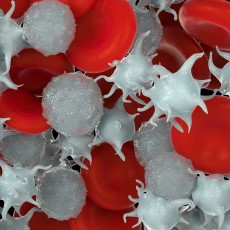
Platelets, also known as thrombocytes, are blood cells. They form in your bone marrow, a sponge-like tissue in your bones. Platelets play a major role in blood clotting. Normally, when one of your blood vessels is injured, you start to bleed. Your platelets will clot (clump together) to plug the hole in the blood vessel and stop the bleeding. You can have different problems with your platelets:
- If your blood has a low number of platelets, it is called thrombocytopenia. This can put you at risk for mild to serious bleeding. The bleeding could be external or internal. There can be various causes. If the problem is mild, you may not need treatment. For more serious cases, you may need medicines or blood or platelet transfusions.
- If your blood has too many platelets, you may have a higher risk of blood clots.
- When the cause is unknown, this is called thrombocythemia. It is rare. You may not need treatment if there are no signs or symptoms. In other cases, people who have it may need treatment with medicines or procedures.
- If another disease or condition is causing the high platelet count, it is thrombocytosis. The treatment and outlook for thrombocytosis depends on what is causing it.
- Another possible problem is that your platelets do not work as they should. For example, in von Willebrand Disease, your platelets cannot stick together or cannot attach to blood vessel walls. This can cause excessive bleeding. There are different types of in von Willebrand Disease; treatment depends on which type you have.
NIH: National Heart, Lung, and Blood Institute
- Platelet Disorders (National Library of Medicine)Platelets, also known as thrombocytes, are blood cells. They form in your bone marrow, a sponge-like tissue in your bones. Platelets play a major role in blood clotting. Normally, ...
- Platelet Tests What are platelet tests? Platelets, also known as thrombocytes, are small blood cells that are essential for blood clotting . Clotting is the process ...
- Blood Thinners (National Library of Medicine)... as aspirin and clopidogrel, prevent blood cells called platelets from clumping together to form a clot. Antiplatelets ...
- Gray platelet syndrome is a bleeding disorder associated with abnormal platelets, which are small blood cells involved in blood clotting. People with this ...
- Acquired platelet function defects are conditions that prevent clotting elements in the blood called platelets from working as they ...
- Congenital platelet function defects are conditions that prevent clotting elements in the blood, called platelets, from working as they ...
- ... blood test shows if you have antibodies against platelets in your blood. Platelets are particles in the blood that help the ... body may produce antibodies that affect its own platelets.
- ... bleeding disorder in which the immune system destroys platelets, which are necessary for normal blood clotting. People with the disease have too few platelets in the blood.
- ... which there is an abnormally low amount of platelets. Platelets are parts of the blood that help blood ... often divided into 3 major causes of low platelets: Not enough platelets are made in the bone ...
- The platelet aggregation blood test checks how well platelets, a part of blood, clump together and cause blood to ... The laboratory specialist will look at how the platelets spread out in the liquid part of the ...



